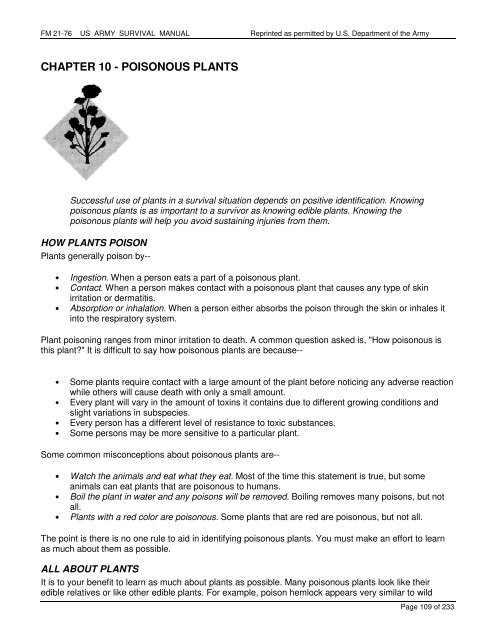FM 21-76 US ARMY SURVIVAL MANUAL
Create successful ePaper yourself
Turn your PDF publications into a flip-book with our unique Google optimized e-Paper software.
<strong>FM</strong> <strong>21</strong>-<strong>76</strong> <strong>US</strong> <strong>ARMY</strong> <strong>SURVIVAL</strong> <strong>MANUAL</strong> Reprinted as permitted by U.S. Department of the Army<br />
CHAPTER 10 - POISONO<strong>US</strong> PLANTS<br />
Successful use of plants in a survival situation depends on positive identification. Knowing<br />
poisonous plants is as important to a survivor as knowing edible plants. Knowing the<br />
poisonous plants will help you avoid sustaining injuries from them.<br />
HOW PLANTS POISON<br />
Plants generally poison by--<br />
• Ingestion. When a person eats a part of a poisonous plant.<br />
• Contact. When a person makes contact with a poisonous plant that causes any type of skin<br />
irritation or dermatitis.<br />
• Absorption or inhalation. When a person either absorbs the poison through the skin or inhales it<br />
into the respiratory system.<br />
Plant poisoning ranges from minor irritation to death. A common question asked is, "How poisonous is<br />
this plant?" It is difficult to say how poisonous plants are because--<br />
• Some plants require contact with a large amount of the plant before noticing any adverse reaction<br />
while others will cause death with only a small amount.<br />
• Every plant will vary in the amount of toxins it contains due to different growing conditions and<br />
slight variations in subspecies.<br />
• Every person has a different level of resistance to toxic substances.<br />
• Some persons may be more sensitive to a particular plant.<br />
Some common misconceptions about poisonous plants are--<br />
• Watch the animals and eat what they eat. Most of the time this statement is true, but some<br />
animals can eat plants that are poisonous to humans.<br />
• Boil the plant in water and any poisons will be removed. Boiling removes many poisons, but not<br />
all.<br />
• Plants with a red color are poisonous. Some plants that are red are poisonous, but not all.<br />
The point is there is no one rule to aid in identifying poisonous plants. You must make an effort to learn<br />
as much about them as possible.<br />
ALL ABOUT PLANTS<br />
It is to your benefit to learn as much about plants as possible. Many poisonous plants look like their<br />
edible relatives or like other edible plants. For example, poison hemlock appears very similar to wild<br />
Page 109 of 233





